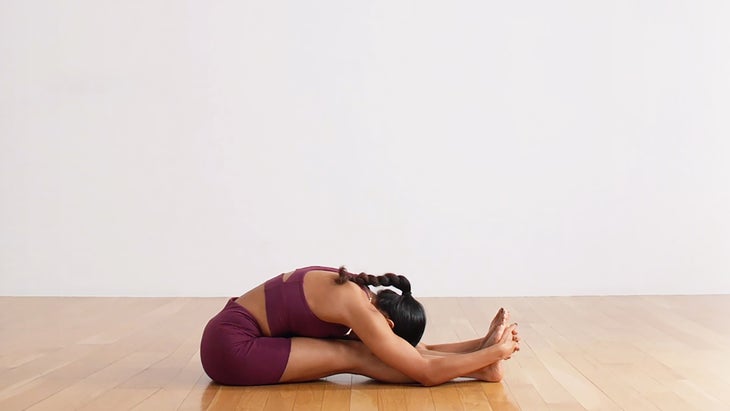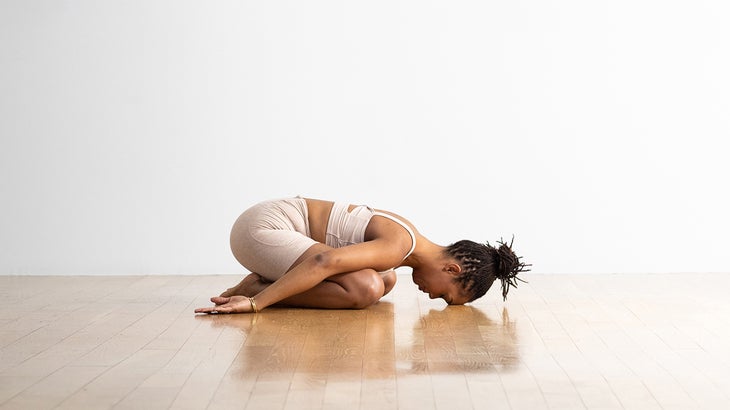“], “filter”: { “nextExceptions”: “img, blockquote, div”, “nextContainsExceptions”: “img, blockquote, a.btn, a.o-button”} }”>
In our go-hard culture, it’s easy to feel as if you’re being pulled in a hundred different directions. You find yourself expending your energy on urgent demands as well as on things that, frankly, seem important to everyone else but you.
When you have a lot going on in your life, it’s not hard to start feeling depleted. You’re made to think that constantly being on the grind is the path to Capital S “success”–or what passes for it. That makes it difficult to slow down and move with intention. But the yoga principle of brahmacharya emphasizes the importance of conserving your energy so that you can direct your attention and creativity more consciously.
Find Moderation in Your Practice
As one of the five yamas, or moral codes of yoga, brahmacharya is most often defined as celibacy. But some teachers expand the definition to include all kinds of creative, second-chakra energy beyond the sexual. Nicolai Bachman, author of The Path of the Yoga Sutras, describes it as “conservation of vital energy.” Many teachers use it to mean “moderation” and apply it to life activities well beyond sexuality.
When you apply this to your asana practice—the physical poses—it may mean finding a balance between sequences that move you briskly from pose to pose and those that can help you slow down and go inward.
Yin yoga, for example, asks you to stretch in poses for up to several minutes at a time, which allows you to spend time feeling your body in unfamiliar postures. Restorative yoga poses are also held for longer periods of time, but with the support of blankets, blocks, bolsters, and other props. When you really need to downregulate, Yoga Nidra offers an opportunity to lie still, quiet your body and your mind, and drop into a profoundly deep rest.
But you can quiet down any yoga practice and make it more inward focused.
How to Conserve Your Energy
This sequence includes folded-over shapes and poses that are downward- and inward facing. That suggests an opportunity for introspection. Don’t try to move quickly from one pose to the next. Take your time getting into the pose, take several breaths, then ease your way into the next position. You may even want to close your eyes to eliminate visual distraction.
When you’re feeling overwhelmed or emotional, a slowed-down sequence of poses could be just what you need to find balance in your body, mind, and feelings.
1. Dandasana (Staff Pose)
Settle into Staff Pose, rooting down through every part of your body that makes a connection with the floor beneath you. Then lengthen your spine, lifting the crown of your head toward the ceiling.

2. Paschimottanasana (Seated Forward Bend)
This Seated Forward Bend gives you many opportunities to practice meeting the needs of your body. When you hinge at your hips to fold into the position, you can keep your legs straight or bend at your knees (a little or a lot). You may place your hands on the floor beside your legs, reach for your toes, or clasp your hands around your feet. Breathe into the pose and, if you like, lightly round and arch your back for a gentle spinal movement. Explore this pose for at least 5 breaths. Then sit up into Dandasana.

3. Janu Sirsasana (Head-to-Knee Forward Bend)
From Dandasana, turn your right foot out, bend your knee, and bring the sole of your foot to press gently against your inner thigh or anywhere along your left leg. On an exhalation, fold forward and reach toward your left foot for Janu Sirsasana. Place your hands on the floor on each side of your leg or grasp your foot with both hands. You may want to close your eyes as you feel yourself relax into the pose. Take 5 or more breaths. Then return to seated.

4. Marichyasana (Marichi’s Pose)
From Janu Sirsasana, place your right foot on the mat in front of your hip so your knee faces toward the ceiling. Inhale and lengthen your spine, then exhale and twist your torso toward your bent leg. You can hold your knee with your hand or wrap your arm around your leg to hug it to your body for Marichi’s Pose. Place your right hand behind your hip for support and, if your neck allows, look toward the right. Stay here for 5 or more breaths. Then release the pose and return to Dandasana.

5. Upavistha Konasana (Wide-Angle Seated Forward Bend)
From Dandasana, spread your feet wide apart with your knees and feet pointed toward the ceiling. Bring both hands to the floor in front of you. You may stay here and explore the stretch. Bend your knees slightly or walk your hands forward and fold forward between your legs. Explore this pose for 5 or more breaths, moving forward or back depending on the level of stretch your body needs.
Return to Dandasana and repeat poses 1-5, taking Head-to-Knee and the Wide-Angle Seated Forward Bend on the other side. Then lie on your stomach.

6. Salabhasana (Locust Pose)
From a prone position, roll your shoulders back and reach your arms alongside your body and your hands toward your feet. You can practice lifting into this pose a number of ways: Lift your head, shoulders, and upper body off the floor; lift your feet and legs; or lift both simultaneously into Locust. In whichever variation you choose, focus on keeping a long, even curve in your spine; don’t compress your lower back or your neck.

7. Child’s pose
From Locust Pose, bring your hands forward and place them, palms down, under your shoulders. Push up and press you hips back into Balasana. Reach your arms alongside your body and your hands toward your feet, or extend your hands forward over head. Stay for 5 breaths or more.

8. Utthan Pristhasana (Lizard Pose)
From Child’s Pose, transition to Lizard Pose by coming to Tabletop then lifting your hips into Downward Facing Dog. Bring your left foot forward and place it along the outside of your left hand. Shift your body forward and try to create a straight line from your head to your right heel. Level your shoulders and your hips to be parallel with the floor.

9. Eka Pada Rajakapotasana (Pigeon Pose)
From Lizard, inch your left foot to the right so that it’s somewhere behind your right hand. Lower your knee and calf on the mat. (Shown here with the right leg forward.) Adjust the angle of your knee so that you feel the stretch in your left hip. Extend your right leg straight behind you and rest the top of your foot on the mat. Adjust your positioning so that your hips are level, placing a blanket, pillow, or bolster under your left hip for support if that makes your Pigeon more accessible. Stay supported with your hands on the floor in front of you or walk your hands forward and drape your body over your bent leg. Stay here for 3 breaths or more.
With your hands beneath your shoulders, press down to lift your chest from the floor. Shift your weight the left, bring your right leg around to the front and return to a seated position. Take a few breaths here. When you are ready, come back to lie on your stomach and practice poses 6-9, taking Lizard and Pigeon on the opposite side.

10. Balasana (Child’s Pose)
Come to your hands and knees in a Tabletop position and, when you’re ready, press your hips toward your heels on an exhalation. Allow your torso to drape over your thighs or adjust your body as needed for comfort. You can bring your knees wider apart to make more room for your front body. Place a block or pillow under your head, or a blanket under your knees or ankles if that is more comfortable. Extend your hands out in overhead, or bring them to prayer position or clasp them behind your head. Rest in this pose as long as it is comfortable for you.
End your practice in Savasana, taking as much time as you can to relax into the pose.
Tamara Jeffries, RYT-200, is a senior editor at Yoga Journal.

